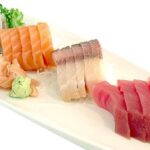Sushi rice is debatably the most important part of the roll. If you make top-notch rice, you’ll have a delicious product. But what do you do if you forgot the rice vinegar? It plays an essential role, but there are a handful of alternatives. Making sushi without rice vinegar shouldn’t be a hassle, and with the info you learn today, it won’t be.
To make sushi rice without rice vinegar, choose apple cider vinegar, white vinegar, or champagne vinegar. White wine and lemon juice are optional, but they’re not as common. Boil sugar, salt, and vegetable oil, then stir it into the cooked rice. Mix it until it’s dry, then use it for the rolls.
Throughout this article, you’ll also learn the following info about making sushi rice without rice vinegar:
- Different flavors and textures for each rice vinegar substitute
- Step-by-step instructions to make sushi rice
- The importance of vinegar in sushi recipes
- Common mistakes and how to avoid them
Choosing a Rice Vinegar Substitute
As shown by Healthline, there are countless substitutes that you can use if you run out of rice vinegar. Don’t panic; You don’t have to run to the store or plan a new meal. The most important part of the process is to use proper ratios (which you’ll learn later in the article). Note that every alternative changes the flavor.
With that in mind, let’s check out five of the best ingredients to make sushi rice without rice vinegar below.
- Try using white vinegar. White vinegar is a common choice because it has the same intense flavor as rice vinegar. Both ingredients add a kick to sushi rice without taking away from the unmistakable taste. White vinegar also prevents bacteria from growing on the sushi.
- Give apple cider vinegar a chance. Much like white vinegar, apple cider vinegar is effective against bacterial growth. It has a unique flavor profile that undeniably changes the rice’s taste. Make sure you make a few batches with ACV before serving it to your guests (you don’t want to mess up the portions!).
- Why not use lemon juice? Lemon juice is very acidic, which means it creates a hostile environment for bacteria. It’s also a delicious ingredient for sushi rice, thanks to its bold, unmistakable taste. You can use fresh lemon juice from lemons or store-bought concentrated lemon juice.
- White wine is an excellent alternative. It’s alcoholic, which is known to prevent bacteria and mold from growing on food. However, a lot of people choose white wine instead of rice vinegar because it’s so flavorful. If you’re a wine fanatic or you’re interested in trying new flavors, give white wine a chance.
- Champagne vinegar is a top choice for many people. Its strong flavor adds a unique spin on sushi rice. It fights bacteria, preserves the sushi’s form, and makes the sushi rice taste a bit sweeter. Since it has a light taste, you should use it if you want the rice’s flavor to come through without being altered.
As you can see, there are several substitutes that you can try if you’re out of rice vinegar. There’s no need to panic; You can use one of the previously mentioned ingredients to make your favorite sushi rice at home. If you’re not sure why people use vinegar in sushi rice or why these substitutes work so well, proceed to the next section.
What Does Vinegar Do for Sushi?
Vinegar is an effective ingredient in sushi. In other words, it’s there for a reason other than flavor. However, we can’t deny that vinegar’s taste profile is an integral part of sushi rice. With that in mind, let’s run through a few reasons that people use rice vinegar (or a replacement) when making sushi rice.
Vinegar Preserves Rice (and Other Food)
Vinegar is known to prevent bacterial growth (as you saw in the previous section). It’s a vital sushi rice ingredient. Sushi goes bad in a few days, so it’s crucial that you use the right type of vinegar to keep it edible as long as possible. Otherwise, the sushi rice will fall apart and get slimy and covered in bacteria.
It Adds a Strong Flavor
Vinegar (apple cider, white, rice, and any other kind) is strong. It’s far from a subtle flavor. If you want to add a delicious seafood boost to your sushi, then vinegar should be a go-to ingredient. It’s strong enough to create a unique flavor, but it won’t overpower other ingredients you put in the sushi roll.
Seasonings Stick to Vinegar
Some types of vinegar get sticky after being mixed into the rice. You’ll learn how to get it done in the next section, but keep in mind that the sticky texture allows various seasonings to stay on the sushi rice. Without vinegar, wine, or lemon juice, your sushi rice might come out tasting bland and flavorless (even if you use plenty of seasonings).
There’s no doubt that rice vinegar is a main sushi rice ingredient. Using one of the substitutes we’ve covered will make a huge difference compared to rice without it. In the next section, you’ll learn how you can make sushi without rice vinegar by trying one of the five suggestions that we’ve provided above.
Making Sushi Rice without Rice Vinegar
Whether you’re out of rice vinegar or you’re looking for a new sushi rice recipe, you’re in the right place. There are a few alternatives, so you can find whichever works best for your recipe. Without further ado, let’s break down the step-by-step process to make sushi rice without rice vinegar.
Here’s what you’ll need to do:
- Boil the sugar, vinegar, and vegetable oil in a pot. According to How Sushi, separating the ingredients into two categories will make it easier to mix in the following steps. Stir these three ingredients together until they’re boiled and thoroughly blended.
- Cook the rice until it’s soft and fluffy. Use a cooking pot to boil water and rice, ensuring that you cover it with a lid. Some people prefer to stir the rice occasionally, but it’s not necessary. The rice is supposed to soak up the water, which means the grains will go wherever they float.
- Slowly pour the mixture from step 1 into the cooked right. When both parts of the meal are made, mix them together in a large glass bowl. Using a see-through bowl will allow you to see if anything isn’t sticking together. Make sure that the boiled mixture and the rice are folded with one another.
- Stir everything together until they’re dry and sticky. Continue the process from step 3 until the rice starts to change its consistency. It’ll stick together in chunks rather than fall apart into individual grains. Using a wooden spoon will prevent the flavor from tasting like metal or plastic.
- Form sheets or layers with the rice. When you’ve thoroughly mixed all of the ingredients, lay it out into sheets. They should be the thickness that you want the rolls to be. Make the rice evenly across the whole sheet to prevent lumps and misshapen sushi rolls (if that’s what you’re using the sushi rice for).
Making high-quality sushi rice doesn’t mean that you have to have sushi vinegar. It’s a common misconception that the perfect sushi recipe relies on the same ingredients with every batch. That being said, there are all sorts of mistakes that people make along the way. To keep your sushi rice tasting as good as possible, read on.
Common Mistakes
If you’re beginning your sushi rice journey, then there’s a chance that you’ve already made a handful of errors (some of which you might not have recognized yet!). Sushi is much more complicated than typical meals, such as pasta, burgers, or salads. Below, you’ll find five must-know mistakes to avoid.
- Boiling everything at the same time is a common problem. Cooking rice typically takes longer than boiling vegetable oil, sugar, and vinegar (or a substitute). If you cook the rice too early, it’ll get cold, hard, and gross. It’s essential that you finish the rice at the same time as the boiled liquids.
- Don’t cook all of the ingredients together. Another beginner problem is trying to toss all of the ingredients in the same pot. Unfortunately, the cooking industry isn’t very forgiving. Make them separately, then stir them together in a glass bowl as mentioned in the previous section.
- Use appropriate, specified measurements. Only the best chefs in the world can eyeball their ingredients. Don’t get ahead of yourself and start guessing how much you need, especially if you’re using new ingredients instead of rice vinegar. The cooking community on Stack Exchange explains that every alternative adds varying flavor intensity.
- Stir it long enough to change the texture. Sushi rice is one of the last meals that you should rush through. It takes time, care, and precision to make a good batch. Failure to do so will result in flavor pockets that are too strong and others that don’t have enough taste or vinegar.
- Don’t mix it for too long. Contrary to the previous mistake, mixing the ingredients for too long will cause the rice to get mushy. Adding too much water can do this as well. When the sushi rice has an even flavor, and it’s sticky enough to roll in your hand, it’s time to form the sheets or layers.
The good news is that these rookie mistakes are easy to avoid. With all of them in mind, you can make a top-shelf, delicious batch of sushi rice. Why not try all of the substitutes to see which one suits your palate? You can narrow your choices to one or two; Who knows? You might like some of them more than rice vinegar!
Why Some People Intentionally Don’t Use Rice Vinegar
You might be reading this page because you just realized that you don’t have any rice vinegar in your pantry. Take a deep breath and relax. A lot of people don’t use rice vinegar because they prefer the alternatives. Just because you don’t have it doesn’t mean you’re out of luck. Let’s review the three primary reasons that chefs use rice vinegar substitutes.
It’s a Bit Too Expensive
You can buy basic rice vinegar at the store for a relatively cheap price. It costs about the same as any of the alternatives, but real organic hand-made rice vinegar is far more expensive than most of them. Compared to apple cider vinegar or lemon juice, hand-made rice vinegar is nearly two to three times the price.
They Want to Alter the Flavor
We all know that different ingredients provide unique flavors. If you want a fruity taste to your sushi rice, use apple cider vinegar. If you prefer a citrus taste, add lemon juice. You can mess around with the ingredients to figure out what you like. For this reason, many at-home chefs try a plethora of rice vinegar subs.
You Can Change Its Texture
Much like the flavor, every ingredient alters the food’s texture. Sushi rice is the structure behind every sushi roll. If you adjust anything, it’s crucial that it doesn’t fall apart. However, white wine, champagne vinegar, and some of the other suggestions from earlier in the post will make it stickier or fluffier.
How to Perfectly Fluff the Sushi Rice
- Add enough water at the start. Water is an essential ingredient. Too much of it ruins the sushi rice, causing it to become loose and mushy. Too little of it makes the sushi rice dry, flaky and burnt. Make sure you know how much water you need before you start cooking the rice.
- Aerate the rice as you cook. Use a porous wooden spoon to stir the rice before and after it’s finished. This process adds oxygen and air pockets to the rice, fluffing it and preventing the sushi from flattening. It doesn’t affect the flavor as much as the texture, which is equally as important.
- Be gentle when you’re making the rolls. Don’t use too much force, or you’ll cause the grains to fall apart. Act as if you had a cotton ball in your hand that you didn’t want to squish. Sushi rice is just as delicate (if not more breakable), so be gentle when you’re rolling it.
- Store it properly. Smart Kitchen recommends storing sushi rice in the fridge for 3 to 5 days in an airtight container to prevent bacterial growth. The article goes on to state that you should do your best to consume the rice within two days for optimal flavor, texture, and smell.
- Don’t let it get too cold while you’re cooking. If your rice gets too cold while you’re mixing or cooking, it’ll crumble apart. Remember that sushi rice is difficult to fix once it’s too broken or dry. Cold air causes dryness, so keep the sushi rice in a moist environment until you’re finished cooking and forming it.
Additional Considerations
- Don’t forget to add different seasonings every time. Try all five substitutes to figure out which one you like the most. If you’re in a panicked, rushed situation where you have to have all of the rice done soon, then opt for vinegar. ACV, white vinegar, or champagne vinegar are the most similar choices to rice vinegar.
- You can use rice wine in place of rice vinegar. Although it’s not on the list, some people prefer to use rice wine. The main reason that we didn’t list it is that it doesn’t fluff as much as the other choices. However, people who don’t care for ultra-fluffy sushi rice would do well by themselves to give it a chance.
- Try not to use a rice cooker unless you have to. Rice cookers are great for speed, but remember that we said rushing yourself isn’t a good thing. Use a cooking pot with a lid to slowly cook the rice. You don’t want burnt sushi rice at the bottom of the rice cooker, nor do you want to dry it out too quickly.
- Strain the rice before you cook it. One of the best tricks is to pour the rice into a colander before you cook it, then run hot water through the rice until it’s clear. This tip will clean the rice grains and prevent the sushi rice from tasting too earthy or dull. It also keeps the sushi rice looking vibrant and flavorful.
Conclusion
You don’t need rice vinegar to make a high-quality, delivery batch of sushi. All you need is one of the various substitutes mentioned in this article and a little bit of patience. As long as you use the correct portions, it’ll taste the same (or better!).
Here’s a quick recap of the post:
- Vinegar is used to preserve sushi for a long time.
- Rice vinegar alternatives will change the sushi’s flavor and texture.
- Fluff the rice to make it taste, look, and feel better.
- Make sure the rice is sticky enough to hold its shape.



